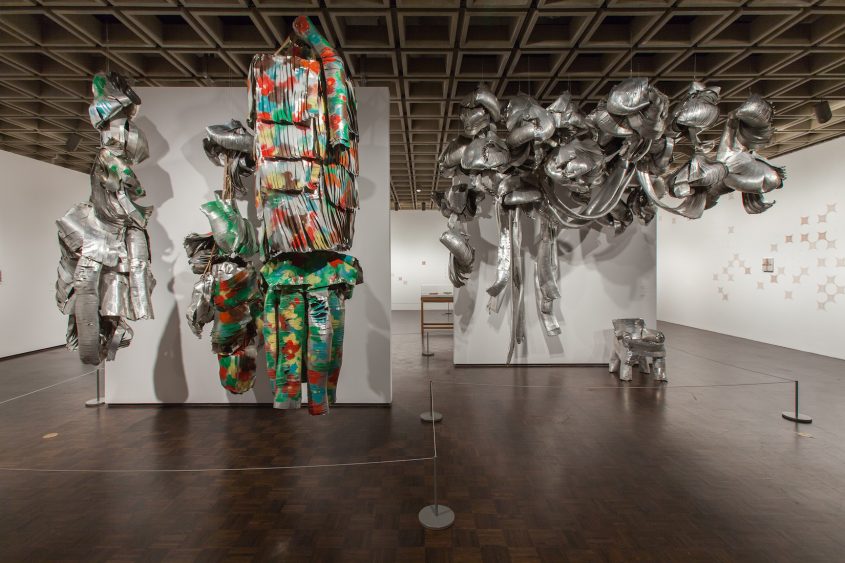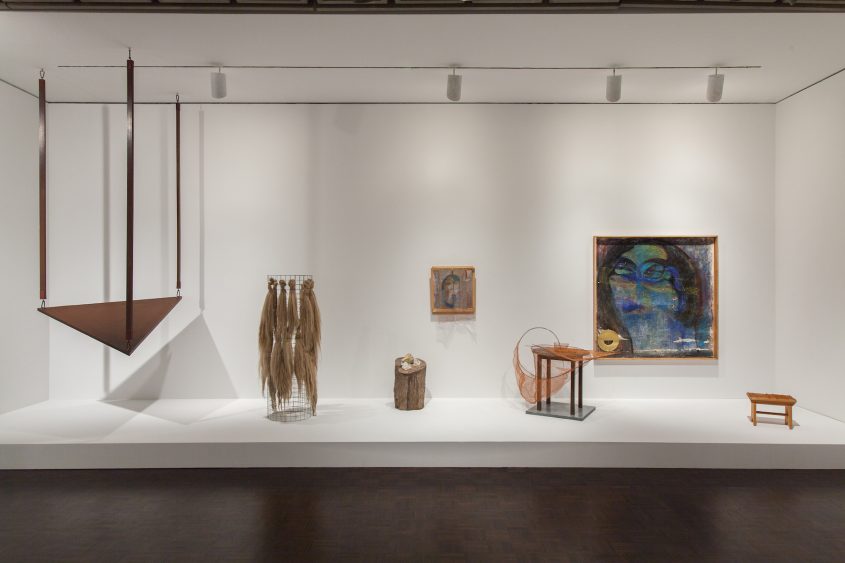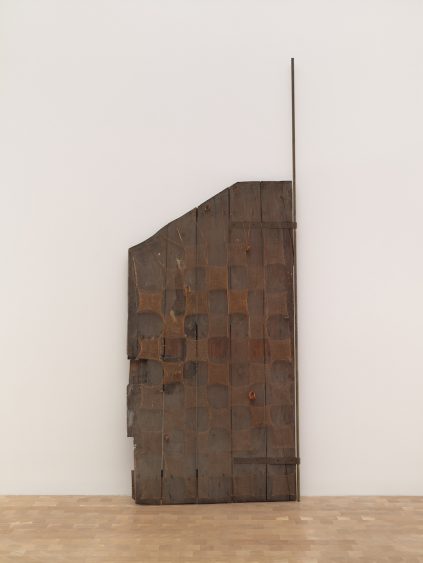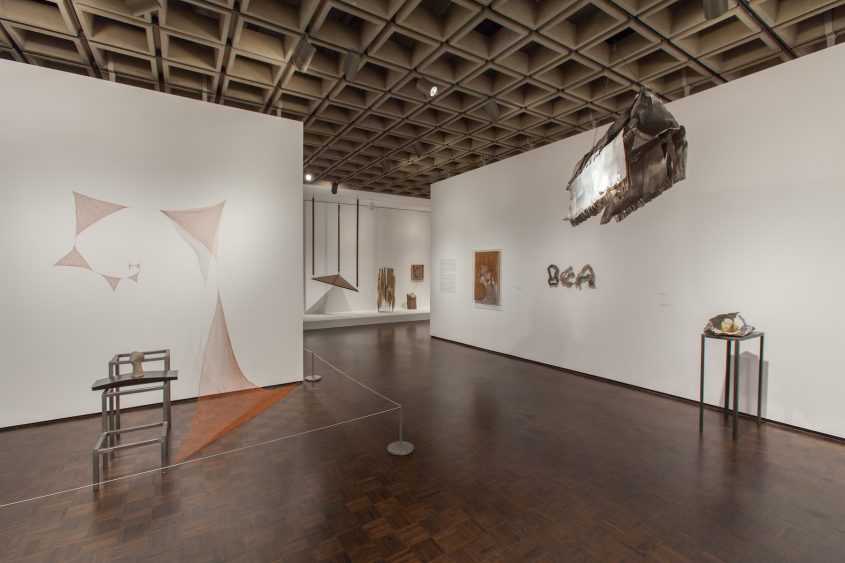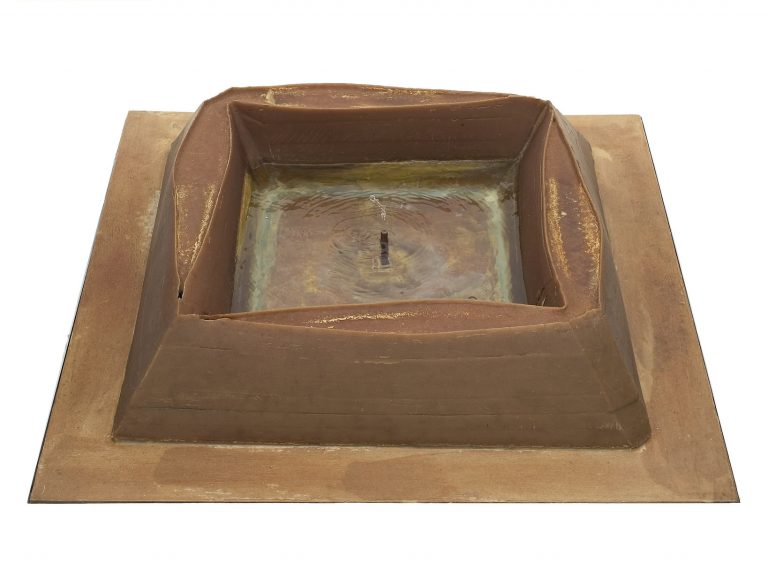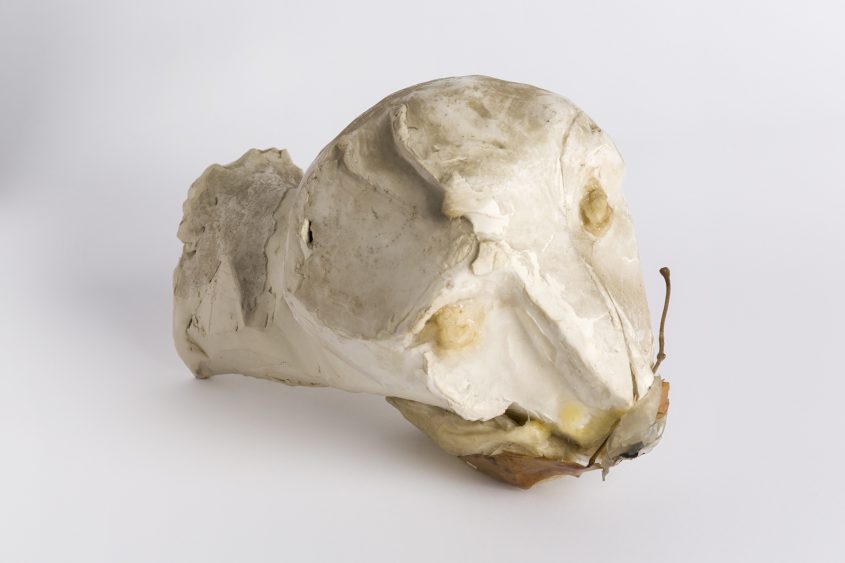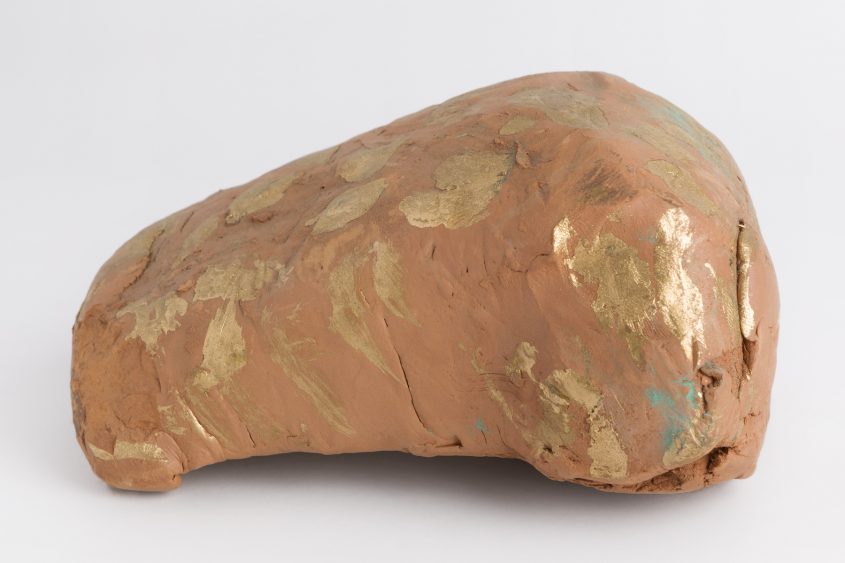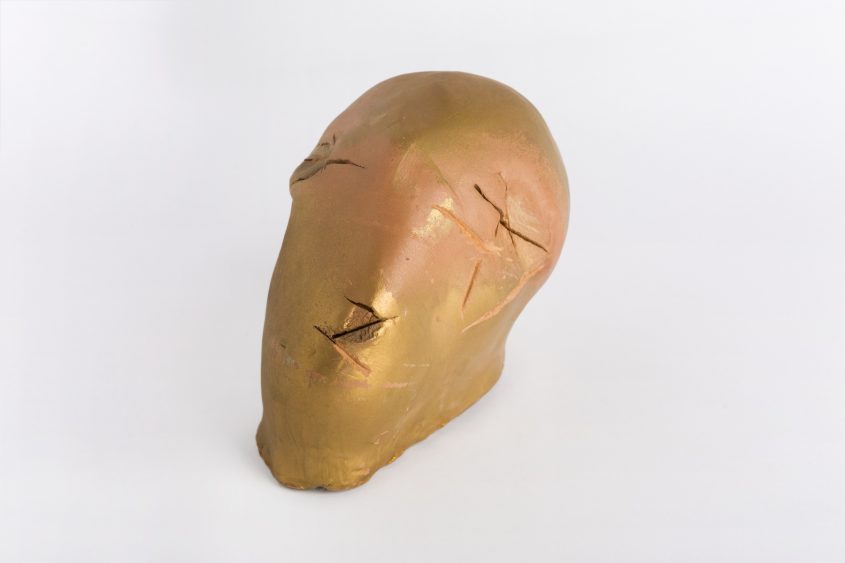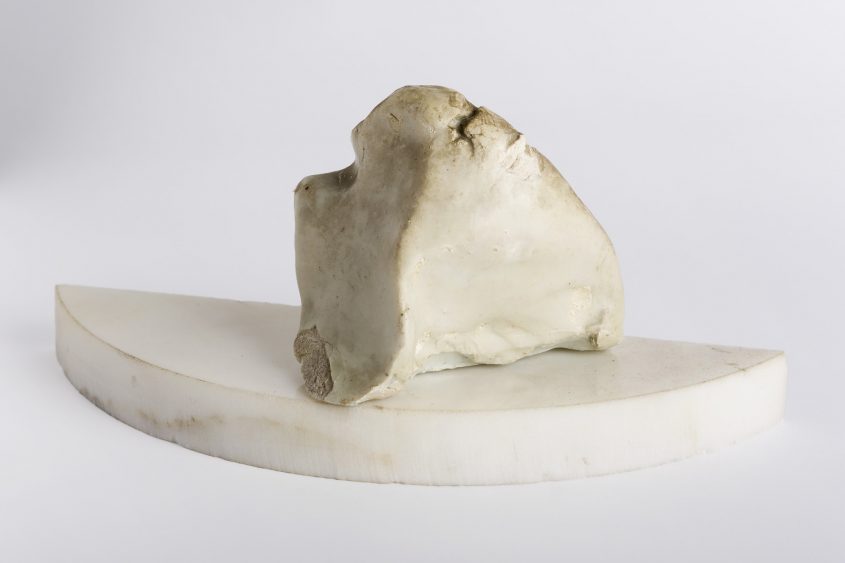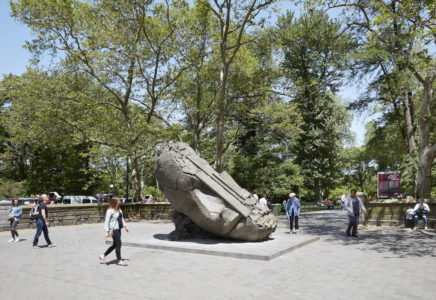Marisa Merz: The sky is a great place au Met Breuer
12Now 86 years old, Marisa Merz is the only woman participant in the outstanding art movement called Arte Povera, a term originated by the Italian critic Germano Celant in a show defining the group, at the Galleria La Bertesca in Genoa in 1967. In the Sixties and Seventies, the Merz family, including Marisa and her husband, the remarkable sculptor Mario Merz, and their daughter Beatrice, lived in Turin. In a revolt against the increasing affluence of post-Second World War Italy, the Merzs and other artists associated with Arte Povera—poor or Impoverished art—decided to forego expensive and luxurious materials in favor of humble elements in their work. In its essence, Arte Povera was a left-wing cultural revolt in opposition to the wealth-building occurring in Italy at the time. The country was embracing swift growth in the economy, along with the acceptance of consumer values. In response to what the group felt was an obsession with money and material goods, its artists rebelled by using poor (cheap) components in their art.
Merz made her work in the apartment in Turin she and her family lived in during the Sixties and Seventies, blurring the distinction between art and life. Their production occurred during a period that existed more or less concomitantly with the American movements of Pop art, minimalism, and conceptual art. There couldn’t be a greater difference between the two outlooks: the American view had to do with a vision of art that was populist and celebrity-oriented (Pop art) or intellectualized, eschewing cultural history (minimalism and conceptual art), whereas the Italian movement belongs to an outlook that did not reject historical culture and tended toward poetic statement. Merz’s work never really did away with associations from the past, especially in the paintings of the very recent years, which echo iconography of the Renaissance.
It is clear that the humble nature of the materials used by the Arte Povera group represents a conscious choice, one in which the radical politics of the period were asserted. One hesitates to decide immediately whether the accomplishment of the Italians’ relatively recent efforts will endure, but it seems to me that their work will inevitably remain known as representing a movement whose broad cultural associations feel genuine, being heavily influenced by political leanings. Merz’s output must be seen in the light of personal choice made public record—while the sculptures and paintings she has created can appear self-effacing in their impromptu directness, they also indicate a vision in which creativity is consciously improvised, favoring a radicalized way of life that rejected easy affluence.
In addition to the works’ politics, from the start Merz’s œuvre was directed toward poetry, one found in her deliberate use of humble materials: steel, iron, copper wire, thread, hemp. Her manufacture might remind us of the work of the contemporary American artist Richard Tuttle, but offhand constructions can be seen more clearly as work eschewing formalism, without political implications. One cannot sever the close connection between art and politics in Merz’s attentions—even if the show’s title, “The Sky Is a Great Space,” is lyric rather than socially confrontational, the silent implications of the work constantly criticize consumer life. As happens in poetry, her points are made indirectly, metaphorically. For example, Living Sculpture (1966), the work first encountered on entering the gallery floor at Met Breuer, is a large constellation of aluminum forms, some vertical and others spherical, that was installed in the kitchen of the artist’s apartment. With this piece, as with those in most of the show, its placement at home is political, even if the forms are not abstract and do not directly provide social commentary. Indeed, the adjective “living” in the title asserts Merz’s determination to make art that we can truly exist with, rather than collect as trophies of status.
But such an orientation does not mean that the work’s formal properties should be ignored. Living Sculpture feels wonderfully complex in its assertion of seemingly anarchic shapes, which consist of overlapping folds of aluminum, in both the vertical and the spherical elements. The work occupies a corner space created by walls installed in the museum space, perhaps a recognition of its installation in the Merz apartment. Another Living Sculpture, also made in 1996 and composed of aluminum, stands like a tree trunk or totem. The overall gestalt looks figurative, while the aluminum sheets, which curl over themselves, construct a system of interlaced shapes that outline the sculpture’s totality. Political content is not felt in these works, but that is to their credit, in the sense that Merz’s rejection of public social assertion adds to their demonstration of a poor esthetic. Good art almost always proceeds by way of implication; we have often seen the failure of art made literal by a politicized outlook. So if Merz suggests rather than asserts, that adds to her distinction.
In an untitled work, also from 1966, scarf-like forms made of hemp are draped vertically around a circular, five-foot column composed of wire mesh. Here simplicity is treated as esthetic fact; the sculpture emphasizes materials as much as overall form. Like many of the sculptures we see in the exhibition, it is an example of pure abstraction. How is it possible to deduce a social outlook from work that is a pure presentation of materials? Only by means of its implications and its milieu. In a 1968 piece called Bea, the name of Merz’s daughter is spelled out in nylon thread, its individual letters placed slightly askew against the support of the wall. As a demonstration of affection, Bea is highly circumspect, but the small sculpture’s modesty enables the quiet assertion of genuine feeling. It is one of the very few pieces, with the exception of the late figurative paintings, which are indicative of affection or spirituality.
A group of small works from the late Sixties through the middle Seventies, usually composed of steel or iron and nylon thread, or copper wire, are diminutive in size and feel extremely unassuming. They suggest knitting in industrial materials. One 1975 work consists of shoes made in copper wire, just over nine inches in length. They are beautiful objects, and Merz’s audience remembers that these pieces express a genuine elegance, either despite, or because of, their unpretentious construction. A small bowl, also constructed in 1975 and made of a mesh of copper wire, can be seen as exemplifying a poetic point of view. Both sculptures are more or less useless as functional items, but their lack of purpose increases their lyric feeling. Other small works, made of metal and nylon thread in the late 1960s, usually possess an open center outlined by a coil of thread, with single thin lines extending beyond sculptures’ middle. There is a humility, both in size and assembly, resulting from their modest facture—an attribute we don’t usually experience in the deliberate ambition of contemporary American art! So there is an unspoken intimation, corrective in nature, to be comprehended from Merz’s career, namely, the evidence that an unassuming art does not necessarily result in an unassuming accomplishment.
Jumping ahead, we find a particularly successful untitled artwork, made in 1993, which consists of a set of three steel table forms, each larger than the other, with open tops. In the middle of the three, we find a small clay head on a thin, slightly curved, horizontal pedestal. The features on the face of the head are simple but poetic; the head looks upward. Behind this small tableau is a constellation of copper mesh panels, constructed in triangular, flag-shaped forms. One group of them hangs above the open-topped tables, while the largest copper component sits on the floor behind them. Somehow the tableau holds true. It is a wonderful grouping that feels personally driven—despite its resolute abstraction. Usually in Merz’s work, the personal is formally expressed without being specific in its communication of intimacy. Emotional closeness is key to this exhibition, even though its overt statement does not often exist (we remember the exception of the work Bea). Merz’s audience finds intimacy especially in her small dimensions, her impoverished materials, and the rejection of monumentality. Art like this exists in contrast to the grand design of minimalism, produced roughly at the same time, which pronounces its ambition in an exorbitant manner. Here it can be said that Merz’s motivation is literally more domestic, directed toward privacy, in tune with a radical reduction of public declaration, although this does not mean in any way that the work is less ambitious or more tentative.
Some of the nicest works in the show are Merz’s simple clay heads; they are small and often placed on pedestals or tripods. Many of the heads in the show are undated; often Merz has deliberately refused to specify the year that they were made—likely to emphasize creative continuity rather than placing them in a single moment of time. They are simple, usually poetic and evocative, and appear to be linked to earlier Italian culture. One head is cracked open, its interior held together with copper wire and gilded with gold leaf; on the outside of the head, teeth, covered in gold leaf, make a striking statement in contrast to the whitish-gray color of the clay. Another work consists of a pair of heads on an iron tripod; made of unfired clay, the smaller gray head appears to be kissing the larger one; the back of the head of the latter is partially painted in blue. In both heads, the hollow, almond-shaped eyes are painted with gold leaf. The two heads appear to be kissing. Intimacy again asserts itself, although here it is demonstrably visible.
While this is a review focusing on Merz’s sculpture, a mention of the paintings and drawing is needed. Distinguished by a finely executed line, most of the drawings are also undated. They often represent female heads that are abstracted to a small degree. The heads demonstrate an affinity for artistic tradition that the sculptural works usually do not share. But they are just as integral and important to the show. Spirituality enters the late paintings; the artist is taking a close look at religious feeling. But in no way is she overtly pious. Again, the emotion is achieved through artistic suggestion and forms that build a bridge to earlier, directly religious Italian art.
Why would a journal such as Sculpture Nature, which focuses on public sculpture, commission a review of Marisa Merz? Perhaps, in a narrow sense, because the art is often made of components found in the earth: clay, copper, hemp. These elements would inevitably connect the art to the outside, natural world, where public art is usually found. Also, Merz’s efforts do away with the distinction between public and private, eradicating the long-established gap between sculpture made to play a public or commemorative role and art whose reference is essentially private. The latter is done for an audience of course, but it is not oriented toward the social directness of a public installation or a meaning tending toward general, as opposed to individual, address. (In fact, as I have mentioned, her home has been an ongoing gallery, surely a decision to maintain private creativity.) In many ways, Merz is a major artist for our time. Her work triumphs as an example of political commitment that refuses to limit itself to conventional expression. In Arte Povera, the choice of materials, and the erasure of the distinction between life and art, not only serve as a warning of the excesses of consumerism. They also show that poetry can be homemade, its quiet assertion the equivalent of a moral readking of live we no longer give to art. Our indifference to an ethics of art is the result of much change in art and social history, and it must be acknowledged. Yet we cannot be consoled by an image solely intended to be bought. As happens with Merz, we find a tenacity and a dignity in the socialization of the art process; these qualities are directed toward communal values rather than money. If she achieves such attributes without directly saying so, we are all the more indebted to her for her graceful discretion.
The Sky is a Great Place
Jusqu’au 7 mai 2017
The MET Breuer
